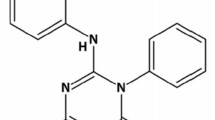Summary
The absorption and elimination of radioactivity after the oral or intraperitoneal administration of [414C]mofebutazone was studied in rats. The blood concentration of radioactivity reached a maximum after about 0.7 h, fell rapidly until about 2 h, and then declined slowly, There was sometimes a second peak between 3–6 h. Elimination of radioactivity in urine and feces was extensive and rapid. Over a 24 h period, 73% of the orally administered radioactivity was eliminated in the urine and 15% in the faeces; most of this was eliminated during the first 8 h (89% of the urine radioactivity, 56% of the faeces radioactivity). In anaesthetized rats with cannulated bile ducts, 94% of the intraperitoneally injected radioactivity was eliminated in the bile over a 6 h period. Most of the radioactivity (about 85%) eliminated in the bile and the urine was in the form of a glucuronide and only small amounts less than 10%, was in the form of mofebutazone.
Similar content being viewed by others
References
Krohs W. (1965): Pyrazole Derivatives in ‘Analgetics’, edited by G. de Stevens, Academic Press, New York, pp 331–403.
Larsen V., Bredahl E. (1966): The embryotoxic effect on rabbits of monophenylbutazone (Monazan®) compared with phenylbutazone and thalidomide. Acta Pharmacol. Toxicol.,24, 443–455.
Thune S. (1967): Comparison of phenyl- and monophenylbutazone (Mobutazon®), especially in respect to the incidence of side effects. A double-blind study. Acta Rheumatolog. Scand.,13, 63–80.
Woodbury J.F.L., Turner W.A., Tiongson R. (1969): Rheumatoid arthritis: comparison of treatment with monophenylbutazone and phenylbutazone. Can. Med. Assoc. J.,101, 801–803.
Scarselli V (1959): Tossicita’ e cinetica dell’eliminazione del 2-fenil, 3,5-diossi, 4-n-butil, pirazolidina comparativamente a quelle del 1,2-difenil-derivato. II Farmaco, Ed. Sei.,14, 347–351.
Holmen-Christensen H. (1967): Identification and UV spectrophotometric determination of phenylbutazone ana-logues from thin-layer chromatograms, in ‘Scientiae Pharmaceuticae’ Vol. II (Proceedings of the 25th Congress of Pharmaceutical Sciences, Prague, 1965), edited by O. Hanc and J. Hubík. Butterworths, London, pp 152–160.
Büchi J., Ammann J., Lieberherr R., Eichenberger E. (1953): Über neue 3,5-Dioxo-pyrazolidine. Helv. Chim. Acta,36, 75–85.
Taylor E.C., Hawks G.H., III, McKillop A. (1968): Thallium in organic synthesis. I. Alkylation and acylation of β-dicarbonyl compounds. J. Amer. Chem. Soc,90, 2421–2422.
Schultz O.-E., Mocha M. (1977): DC-Direktauswertung von Monophenylbutazon und das Problem seiner Stabilität in pharmazeutischen Spezialitäten. Pharm. Ztg.,122, 1305–1313.
Salzmann U. (1971): Zur Dünnschichtchromatographie von l-Phenyl-4-n-butyl-3,5-dioxo-pyrazolidin (Monophenylbutazon). Pharm. Acta Helv.,46, 721–729.
Woodruff M., Polya J.B. (1974): Pyrazolidine-3,5-diones with heterocyclic substituents. I. Preparation of 3-phenyl-1,2,4-triyzolyl derivatives. Aust. J. Chem.,27, 2447–2454.
Veibel S., Linholter S., Sorensen P. (1958): Pyrazole studies. XI. Oxidation by air of 1:4-disubstituted pyrazolidine-3:5-diones. Acta Chem. Scand.12, 1359–1363.
Woodruff M., Polya J.B. (1975): Pyrazolidine-3,5-diones with heterocyclic substituents. III. Oxidation of 4-monoalkylpyrazolidine-3,5-diones. Aust. J. Chem.,28, 421–426.
Klemm K., Langenscheid E. (1970): Verfahren zur Herstellung von 2-Butyl-N,N’-diphenyl-malono-monohydrazid und seinen Calcium-, Magnesium- und Aluminiumsalzen. Bundesrepublik Deutschland Offenlegungsschrift 2 055 845.
Shusherina N.P., Levina R.Ya., Lurè M.Yu. (1956): Cyanoethylated ketones in the synthesis of unsaturated δ-lactones. V. Synthesis and properties of unsaturated δ-lactones from monocyanoethylated derivatives of acetone and cyclohexanone. Zhur. Obshchei Khim.,26, 750–755; Chem. Abstr.,50, 1470ld (1956).
Bridges J.W., Kibby M.R., Williams R.T. (1965): The structure of the glucuronide of sulphadimethoxine formed in man. Biochem. J.,96, 829–836.
Schulte K.E., Rendic S., Henke G., Mrongovius R.I. (1978): Pharmacokinetics and disposition of orally administered [2,3-l4C] succinimide in the rat. Europ. J. Drug Metab. Pharmacokinet.,3, 31–38.
El-Hawari A.M., Plaa G.L. (1978): Role of the enterohepatic circulation in the elimination of Phenytoin in the rat. Drug Metab. Disp.,6, 59–69.
Bakke O.M., Draffan G.H., Davies D.S. (1974): The metabolism of phenylbutazone in the rat. Xenobiotica,4, 237–254.
Dean H.G., Donovan B., Rylett P. (1976): The distribution and excretion of,4-C and -’H-labelled 4-prenyl-l,2-diphenyl-3,5-pyrazolidinedione (DA 2370) in the rat. Arzneim.-Forsch.,26, 1574–1581.
Ludwig G., Ache I.-M. (1973): Untersuchungen mitl4C -markierten Butyl-malonsäure-mono-(l,2-diphenyl-hydrazid)-Calcium (Bumadizon-Calcium). Stoffwechsel und Kinetik. Arzneim.-Forsch.,23, 1226–1231.
Testa B., Jenner P. (1976): Drug Metabolism: Chemical and Biochemical Aspects. Marcel Dekker Inc., New York. p 200.
Awang D.V.C., Vincent A., Matsui F. (1973): Pattern of phenylbutazone degradation. J.Pharm. Sei.,62, 1673–1676.
Toft P., Dring L.G., Hirom P.C., Williams R.T., Donetti A., Midgley J.M. (1975): The metabolism of [l4C] prenazone in the rat. Xenobiotica,5, 729–739.
Seebald H., Forth W. (1977): Absorption of14C-bumadizone-Ca andl4C-phenylbutazone in isolated intestinal segments in vitro and tied-off gastrointestinal sections in vivo of rats and guinea pigs. Arzneim.-Forsch.,27, 624–635.
Dieterle W., Faigle J.W., Mory H., Richter W.J., Theobald W. (1975): Biotransformation and pharmacokinetics of sulfinpyrazone (Anturan®) in man. Europ. J. Clin. Pharmacol.,9, 135–145.
Dieterle W., Faigle J.W., Früh F., Mory H., Theobald W., Alt K.O., Richter W.J. (1976): Metabolism of phenylbutazone in man. Arzneim.-Forsch.,26, 572–577.
Faigle J.W., Dieterle W. (1977): The biotransformation of phenylbutazone (Butazolidin®). J. Internat. Med. Res.,5, Supplement 2, 2–14.
Sahli M., Ziegler H. (1961): Zur Analytik des 1-Phenyl-4n-butyl-3,5-dioxopyrazolidins. Arch. Pharm. Chem.,68, 186–197.
Author information
Authors and Affiliations
Rights and permissions
About this article
Cite this article
Bass, V., Mrongovius, R.I. & Schulte, K.E. Disposition of [4-14C]mofebutazone in the rat. European Journal of Drug Metabolism and Pharmacokinetics 5, 201–206 (1980). https://doi.org/10.1007/BF03189465
Received:
Issue Date:
DOI: https://doi.org/10.1007/BF03189465




